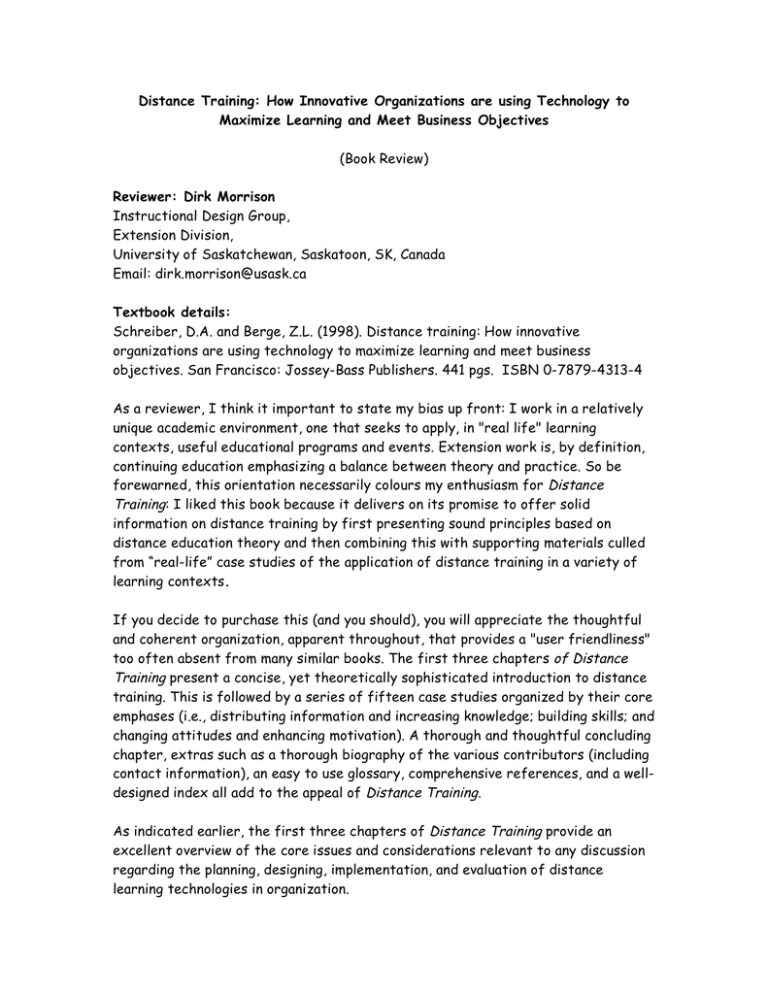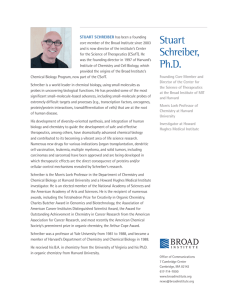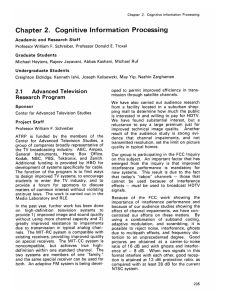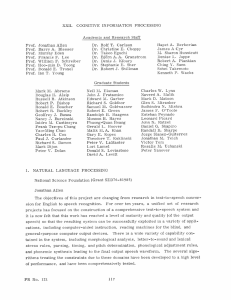Distance Training: How Innovative Organizations are using Technology to
advertisement

Distance Training: How Innovative Organizations are using Technology to Maximize Learning and Meet Business Objectives (Book Review) Reviewer: Dirk Morrison Instructional Design Group, Extension Division, University of Saskatchewan, Saskatoon, SK, Canada Email: dirk.morrison@usask.ca Textbook details: Schreiber, D.A. and Berge, Z.L. (1998). Distance training: How innovative organizations are using technology to maximize learning and meet business objectives. San Francisco: Jossey-Bass Publishers. 441 pgs. ISBN 0-7879-4313-4 As a reviewer, I think it important to state my bias up front: I work in a relatively unique academic environment, one that seeks to apply, in "real life" learning contexts, useful educational programs and events. Extension work is, by definition, continuing education emphasizing a balance between theory and practice. So be forewarned, this orientation necessarily colours my enthusiasm for Distance Training: I liked this book because it delivers on its promise to offer solid information on distance training by first presenting sound principles based on distance education theory and then combining this with supporting materials culled from “real-life” case studies of the application of distance training in a variety of learning contexts. If you decide to purchase this (and you should), you will appreciate the thoughtful and coherent organization, apparent throughout, that provides a "user friendliness" too often absent from many similar books. The first three chapters of Distance Training present a concise, yet theoretically sophisticated introduction to distance training. This is followed by a series of fifteen case studies organized by their core emphases (i.e., distributing information and increasing knowledge; building skills; and changing attitudes and enhancing motivation). A thorough and thoughtful concluding chapter, extras such as a thorough biography of the various contributors (including contact information), an easy to use glossary, comprehensive references, and a welldesigned index all add to the appeal of Distance Training. As indicated earlier, the first three chapters of Distance Training provide an excellent overview of the core issues and considerations relevant to any discussion regarding the planning, designing, implementation, and evaluation of distance learning technologies in organization. Chapter One, “Organizational Technology and Its Impact on Distance Training,” written by Deborah Schreiber, opens with familiar hand-wringing about the need to develop and maintain an “educated, high performance workforce.” The now classic answer to this concern , is “an array of technological supports to meet this need” (p.3). Schreiber quickly points out, however, that some of our old notions regarding how to best meet the demands of lifelong learning as applied to the world of work are sorely inadequate. For example, the idea of individuals coming to training is, according to Schreiber, obsolete and hopelessly passive (p. 3). The other end of the spectrum—trainers and education specialists attempting to catch every new wave and fashion in communications technology in the hopes of finding the “silver bullet” to fix all that is ailing in training and development—is also seen to be ineffective. Instead, Schreiber points to a more potent strategy—one that would employ a variety of forms of methods and technologies of instruction, and one that is informed by the training needs and contexts of the organization. This is but one example of the kind of clear thinking and common sense solutions Schreiber offers throughout this chapter. Spending an all-too brief section on the history of distance training and business, Schreiber moves on to discussions regarding the integration of computers and telecommunications technologies to realize the collaborative potential of distance – delivered training. While she discusses merging technologies, tele-training organizations, restructuring and boundary-less workplaces, it is her treatise regarding the implementation of learning technologies in the context of a team environment that proved most interesting. One of her central theses in this discussion is that members from different organizational units will likely come to the table of cooperation/collaboration with very different organizational and psychological orientations. Schreiber points out, for instance, that human resource “types” would likely have a very humanistic orientation to training (i.e., focussed on people and their development), while technical staff likely gravitate to a taskfocused and analytical perspective, focussing on the "bottom-line" and measured outcomes. Team members' ability to work cooperatively on the implementation of a distance training initiative wouldbe affected by these orientations and depend upon how well they could put their differences aside and work in the given context of the organization. A second gem in this chapter was Schreiber’s concept of organizational maturity regarding readiness to successfully adopt and implement distance learning technology. Her claim is that any organization moves along a scale from immature processes to sophisticated processes, each step of the way being demarcated by increased sophistication of integration processes, culminating in the institutionalization of distance/distributed learning in within the organization (p.13). Chapter Two, “Conceptual Frameworks in Distance Training and Education,” written by Zane Berge, concisely synthesizes a wealth of knowledge gleaned from a broad swath of distance education theory. For example, he emphasizes the point that all trainers come to the distance training context with prior experiences, values, etc. that will necessarily influence their choices around educational technologies and the methods they employ. I especially appreciated Berge’s wonderful metaphor that cleverly portrays the epistemological landscape of distance training contexts that neatly divides pedagogy between the conceptual frameworks of knowledge transmission versus knowledge transformation. The ancient craft of storytelling around a campfire, learners sitting at the feet of elders to become informed, even enlightened, is a familiar metaphor and is likened to training models that emphasize the transmission of knowledge, skills, and wisdom from the known to the knower. Berge uses the metaphor of the watering hole, emphasizing collegial exchange between all participants, along all manner of knowledge areas; the emphasis here is the social and shared culture of learning. Finally, the metaphorical solitude of the cave is likened to the necessary process of retreat to "make meaning,” a personal space required to “internalize knowledge and make it one’s own” (p.20). Berge then expands on these conceptual frameworks, categorizing the transmission model as essentially drawing from positivism and behaviourism to inform practice. The transformation model is described as having two primary influences, one from cognitive constuctivism and the other from social constuctivism; this dual emphasis on individual and social thinking and construction of meaning is well-balanced with enough primary references to satisfy those curious enough to explore further. It is important to note that Berge makes the logical connection between the above frameworks and the implications for methods and models of teaching and learning appropriate for distance training. For example, his description of teacher-centred and learner-centred training approaches sensibly informs the transition from these fundamental principles to a discussion of factors critical to the implementation of technology-mediated training and education. Sprinkled throughout are a number of tables and diagrams that effectively summarize the essence of these discussions. Finally, Berge ends with an important focus, namely, the changing roles of students, instructors, curriculum and organizations. Interwoven into these latter discussions is the point that the various factors (e.g., nature of the learning environment, learning outcomes, curriculum, etc.) are all influenced by educational paradigms, which, in turn, are chosen and informed by underlying philosophies of education. A concluding note pointing to the dismantling of barriers that have previously isolated training and education from the rest of the workplace as inevitable gives impetus to explore and discover new models and frameworks to support the expanding learning topography. The third chapter in Distance Training, Instructional Design of Distance Training, also by Schreiber, presents us with an appealing tapestry of useful content, expertly weaving theory and practice into a coherent whole. For example, in each instance where she introduces a new concept, such as her instructional design model for distance training (IDM-DT), Schreiber carefully breaks down the important “chunks” of the idea with further explanations. More importantly, she gives examples of what one would actually do at each stage to use the idea in practice. The Case Studies The clustering of a series of illustrative case studies around pedagogical themes, namely, distributing information and increasing knowledge, building skills (technical and critical thinking), and changing attitudes and enhancing motivation, is an especially useful strategy. While I would consider the first three chapters mandatory reading, the case studies are certainly optional. one may allow one’s particular interests be the guide. In other words, there is no need to read this part of the book in any particular sequence; rather, pick and choose those cases of most interest and relevance to your distance training context. The authors’ selection of case studies from across a broad spectrum of distance training contexts is impressive. For example, Part One, Distributing Information and Increasing Knowledge kicks off with a chapter focusing on building customer relations for the home improvement industry via web-based training. Other chapters in this collection cover the spectrum, from high tech, large scale enterprises like NYNEX Corporation, to the time-sensitive information dissemination and regulation sensitive information challenges of the American Red Cross Biomedical Services and Mortgage Bankers Association of America respectively. The last chapter in this section focuses on a partnership between government and higher education to deliver a graduate program in Rehabilitative Counseling. Part Two, Building Skills, shifts the emphasis to illustrating programs that build both technical and critical thinking skills via distance training. The section starts off with an intriguing story of Unisys Corporation’s bold steps into distance education to tackle a massive retraining challenge. One doesn’t have to think long and hard to come up with a better choice for testing the effectiveness of delivering technical training at a distance than the Federal Aviation Administration, precisely the focus of the next chapter in this section. This is followed by the eleventh chapter, which focuses on health, with the next chapter describing an international setting, namely, Malaysia’s Virtual University. Chapter thirteen shines light on the value of building skills with online technology by reporting on the online training costs and evaluation at the Texas Natural Resource Conservation Commission. Finally, chapter fourteen wraps things up with a look at building intranet courseware using multi-disciplinary teams, through the lens of the case studies of Quantum Solutions, Inc. and Columbia/HCA Healthcare Corporation. Part Three, Changing Attitudes and Enhancing Motivation , is particularly intriguing because it tackles what most texts avoid by omission, namely, changing attitudes and enhancing motivation in teaching and learning contexts. For example, Chapter fifteen recounts the tale of an innovative distance learning program at the Columbus Center wherein a main goal was to elicit community beliefs and change attitudes regarding marine biotechnology through education. The case study of the Interactive Distance Learning Group, Inc. presents a rich resource for evaluators wishing to measure existing attitudes to assess training transfer. Chapter seventeen provides a unique focus on the experiences of a construction company, H.B. Zachry Company and their happy discovery of unanticipated attitudinal changes among employees as a result of a distance training initiative. The final chapter of this section describes, in detail, a model used to “reframe thinking about telelearning” in the distance education initiatives for executive development within the US Navy’s Bureau of Medicine and Surgery. The concluding chapter, Best Practices of Distance Training, by Schreiber, does an excellent job of summarizing many of the lessons encountered thus far. Of special import is her treatise on the impact of corporate culture on distance training and her very useful strategic tips, drawn from many of the case studies, on how to ensure the distance training initiative is successful. Schreiber wisely revisits, and adds to, earlier discussions concerning conceptual frameworks for types of learning at a distance as well as a section correlating instructional methodologies and distance delivery technologies. Conclusion If there can be any substantial criticism of Distance Training, it is that the overwhelming majority of the case studies are American. In this author’s opinion, Distance Training would be strengthened immensely by a more international focus. Granted, this text is likely targeted toward a North American audience, but there is much to learn from international applications of learning technologies applied to distance training. Besides, it would just make for a more interesting read! [As an aside, being a member of a large organization, namely, a university, I found it both amusing and informative that there were so many parallels between what was being described in a book focused on “training” in a business context and that of the university. Although Distance Training provides a useful set of definitions that distinguish between training and education, one wonders whether these differences are becoming increasingly artificial as the barriers between institutions of higher learning and other organizations begin to dissolve. It is clear that some of the things business concerns itself with are clearly educative in the traditional sense, while at other times, much of what takes place within, say, university settings is simply sophisticated skills training. As universities move increasingly toward partnerships with business and industry, and business and industry moves toward becoming “learning organizations” it may be that these differences begin to blur significantly.] Distance Training is a solid piece of work, one that will prove useful time and again for anyone with responsibilities for the design, development, delivery, and evaluation of distance learning initiatives in organizations. I would whole-heartedly agree with Michael P. Lambert, executive director, Distance Education and Training Council, quoted on the text jacket who says, “This manual is the one we’ve been waiting for!”





